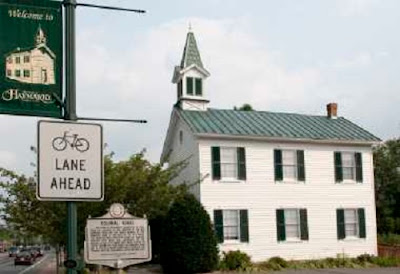American
Historic Small Towns Itineraries
A Civil War experience at the Manassas National
Battlefield Park, Family Arts and Entertainment, History at the National Museum
of the Marine Corps, National Parks and the Outdoors, Antique Shops, Cafes,
Restaurants, Art Stores and Boutiques in:
Bristow most of the area was
previously part of the Linton's Ford Plantation, owned by the Linton Family
from the 18th century. In 1894, Sarah Linton converted to
Catholicism, the property was deeded to the Roman Catholic Church and the
Linton Hall School was founded; in the late 20th century, much
of the original property was sold to developers to raise money to support the
school.
Dumfries the largest town in Prince William County
was chartered in 1749. It is named for a town in Scotland from where a locally
prominent merchant hailed. It grew in wealth and importance as a tobacco port
rivaling New York and Boston; soil erosion and silting ended the trade. Today,
Dumfries is known as the oldest continually chartered town in Virginia, home to
the Weems-Botts Museum and as keeper of much of our Nation’s early history.
Gainesville was once a changing point for stagecoach horses on the Fauquier
& Alexandria Turnpike. In 1852, the Manassas Gap Railroad reached the area
and the stop became Gainesville. The town was a shipping point for grain,
timber and cattle and remained a major shipping point into the early 1960’s.
During the Civil War, nearby Thoroughfare Gap in the Bull Run Mountains served
as a path for soldiers to reach the First and Second Battles of Manassas.
Haymarket, in northwest Prince William, owes its location to an abandoned
Indian hunting path which became Old Carolina Road. It was used by settlers as
a route from Pennsylvania to the Carolinas. Haymarket grew around the
intersection of Carolina and Dumfries Roads. It was burned by Union troops in
1862. Since then, the town has been revived with a collection of quaint
restored buildings and shops.
Reduce Transit Times and Travel Cost on Your Next Trip
Manassas is 10 square miles of
homes, the arts, entertainment and community events. With more than 40,000
residents, it serves as a transportation and business hub. Steeped in history
and tradition, the city center has an old town feel with a city square type
event pavilion - the Harris Pavilion. Residents and visitors can watch a
band or attend an ice cream social in the summer and ice skate in the winter.
The city also offers a museum rich in Civil War and local Virginia history.
Occoquan in the early 1600s, the
Occoquan River Watershed was occupied by the Dogues, an Algonquian tribe. In
the Dogue Dialect, Occoquan means at the end of the water. It has been a
successful industrial settlement as well as the site of Civil War skirmishes.
Today, Occoquan is a small community rich in history with local shops, a
waterfront, outdoor dining, ghost walks, and a boat dock.
Quantico rich in military history, Quantico is the
only town in the U.S. that is surrounded by a Marine Corps Base. Quantico's
military tradition dates-back to the Revolutionary and Civil Wars, when the
area was used by Virginia Naval elements. The area also spent time as a resort
community called "Potomac". Incorporated in 1872, it takes its name
from a Douge Indian word meaning by the large stream. Today it is home to a
notable Marine Corps Base, established in 1917.
Woodbridge offers a wide range of recreational and leisure opportunities. Outdoor
recreational enthusiasts can access both a state and national park, the Potomac
River, and numerous hiking and biking trails. Woodbridge is also the place to
be for shopping and dining with Potomac Mills and numerous small shops and
restaurants throughout the community.
A Historic
Small-Town Travel Experience in Prince William County Virginia






No comments:
Post a Comment